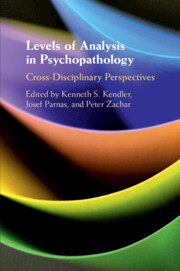Book contents
- Levels of Analysis in Psychopathology
- Advance Praise for Levels of Analysis in Psychopathology
- Levels of Analysis in Psychopathology
- Copyright page
- Contents
- Figures
- Tables
- Contributors
- Preface
- General Introduction
- Part I Neuroscience, Mechanisms, and RDoC
- Part II Phenomenology, Biological Psychology, and the Mind–Body Problem
- Section 4
- 10 Introduction
- 11 Body Self-Awareness: Multiple Levels or Dynamical Gestalt?
- 12 Commentary on Gallagher “Body Self-Awareness: Multiple Levels or Dynamical Gestalt?”
- Section 5
- Section 6
- Section 7
- Part III Taxonomy, Integration, and Multiple Levels of Explanation
- Index
- References
11 - Body Self-Awareness: Multiple Levels or Dynamical Gestalt?
from Section 4
Published online by Cambridge University Press: 02 April 2020
- Levels of Analysis in Psychopathology
- Advance Praise for Levels of Analysis in Psychopathology
- Levels of Analysis in Psychopathology
- Copyright page
- Contents
- Figures
- Tables
- Contributors
- Preface
- General Introduction
- Part I Neuroscience, Mechanisms, and RDoC
- Part II Phenomenology, Biological Psychology, and the Mind–Body Problem
- Section 4
- 10 Introduction
- 11 Body Self-Awareness: Multiple Levels or Dynamical Gestalt?
- 12 Commentary on Gallagher “Body Self-Awareness: Multiple Levels or Dynamical Gestalt?”
- Section 5
- Section 6
- Section 7
- Part III Taxonomy, Integration, and Multiple Levels of Explanation
- Index
- References
Summary
This chapter reviews some central issues concerning body self-awareness, the sense of ownership, and how these phenomena are modulated in psychopathology. I argue that various aspects of body self-awareness can be organized in a relatively coherent manner by thinking of them in terms of dynamical gestalts. Taking this approach moves us away from thinking of these issues as involving multiple or different levels, or conceiving of them under hierarchical descriptions that refer to ‘top-down’ versus ‘bottom-up’ processes. Thinking of body self-awareness on the model of a dynamical gestalt allows us to see how different forms of pre-reflective and reflective self-awareness are related in a more holistic fashion.
Keywords
- Type
- Chapter
- Information
- Levels of Analysis in PsychopathologyCross-Disciplinary Perspectives, pp. 131 - 159Publisher: Cambridge University PressPrint publication year: 2020



